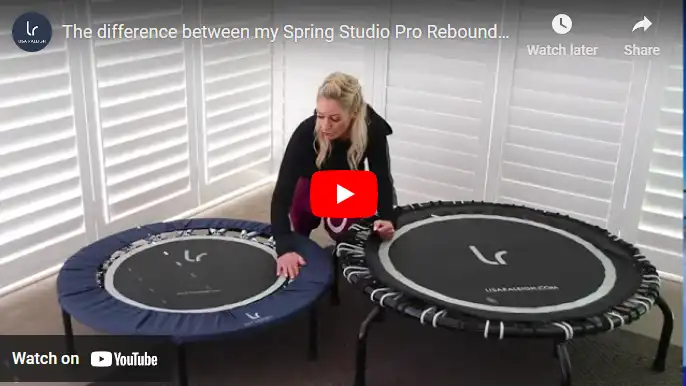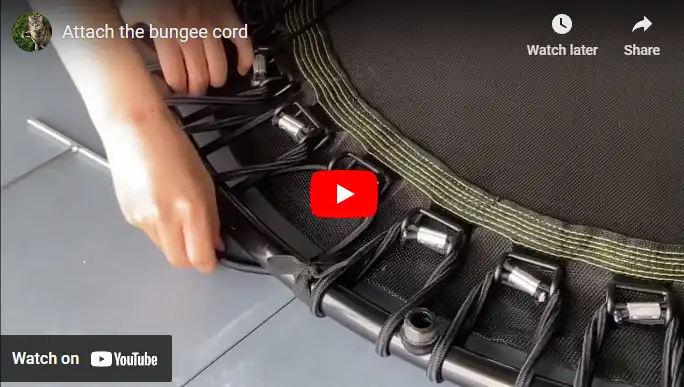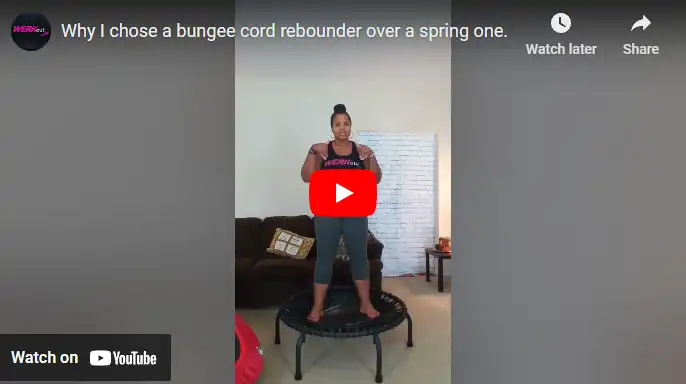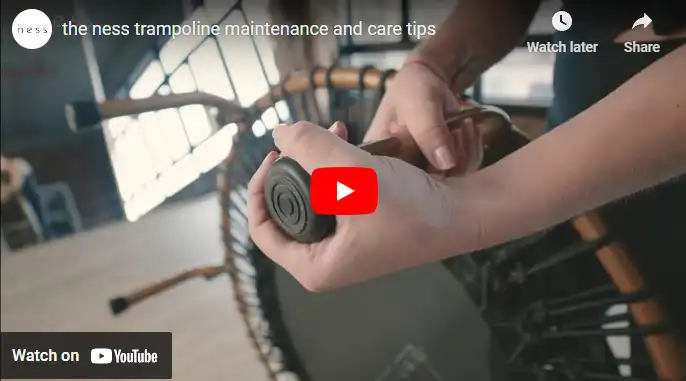Bungee Vs. Springs Rebounders: Pros, Cons, and Comparison
Disclaimer: This website exists thanks to you, the readers. When you buy through links on my site, I may earn an affiliate commission.
Ready to jump into the great rebounder debate? It's bungee vs. springs rebounders, the ultimate bounce-off!
On one corner, we have the spring rebounder, the OG of the bouncing world. Springs give you that classic, zesty bounce that can turn any workout into a mini trampoline party!
Then, there's the bungee rebounder, the zen master of the bounce world. It's like floating on a cloud, if that cloud was super quiet and easy on the knees. Perfect for those who prefer to sneak in a workout while the baby sleeps.
So, are you Team Spring with its lively bounce and squeaky soundtrack, or Team Bungee, the smooth, silent type? Now, let’s hop right in and help you choose the best rebounder for your needs.
Comparison Table: Bungee vs. Springs Rebounders
When it comes to the best rebounders, there is hardly one right answer for all. Each type, each model, each brand has its pros and cons.
The choice between a spring rebounder and a bungee rebounder has a lot to do with your personal preferences. Below I’ve compared a few of the main characteristics of the two types of mini trampolines to give you a clearer view of their differences.
Feature | Spring rebounder | Bungee rebounder |
|---|---|---|
Bounce | - firm bounce, not recommended for sensitive joints | + gentle bounce, easy on the joints |
Price | + more well-known on the market, hence sold at a reasonable price | - most models tend to be quite expensive |
Setup | + comes pre-assembled most of the time | - might need assembling of the bungees to the frame |
Quietness | - steel springs do make noise, especially on cheap trampolines | + bungees are usually more quiet than springs |
Keep in mind, though, that no matter which type you choose, your best bet will always be to buy a high-quality product.
As the therapists at Rebound Fitness say:
“Before going into the different experiences you will have on these style rebounders, it’s important to note that with both designs to get the best experience, the best results, and the best longevity of use then choose a high-quality premium rebounder that is designed and built to the top quality specification needed to bounce safely and effectively using high-quality individual components.”
Now let’s dive into the specifics of each type of rebounder.
The spring rebounder
First, let's look at spring rebounders and how they work.
How does a spring rebounder work?
Spring rebounders are the default choice, the old kid on the block, with the mat and the frame connected via steel springs. This type of mini trampoline gives you a short, quick bounce.
This is because of the connection of the mat to the springs – it’s simply less elastic than bungee trampolines.
Spring rebounder trampolines are great if you want a more intense workout. The downside is it’s harder on your joints due to that lack of elasticity.
In terms of noise, there’s always going to be some, since the metal springs are hooked to a metal rim. You can reduce this with a bit of WD-40 on these metal parts.
Types of springs used in rebounder
If you’re looking for a spring-type rebounder, one thing to consider is the type of springs. On the market, you can most frequently find tube or tapered steel strings. The former might be cheaper, but the latter is proven to be more durable and reliable.
The length of the springs is key for the quality of bouncing. If they are short, you’ll get a stiffer bounce because they can stretch only so much. When the springs stop stretching, you’ll feel a sudden stop of the bounce and that is not good for your joints and back.
Also, short springs are likely to wear out more quickly. They are usually cheaper and made from lower-quality steel. By contrast, longer springs provide wider stretch and that helps your body absorb the intensity of the bounce more gently and efficiently.
There is one more thing. Some rebounders are designed with springs that vary in size—larger in the middle and smaller towards the ends. This design enables various parts of the spring to stretch with differing ease. The result is a gradation in the spring's strength across its length, making your bounce gentler.
What is considered a long spring, though? My advice is to avoid anything shorter than 7 inches – the ones between 8 and 10 inches provide better bounce and last longer.
Durability and longevity
Different rebounders are constructed to withstand different weight capacities, so this is something crucial to think about when looking at bungee vs. springs rebounders.
Speaking of durability of spring vs. bungee rebounders, my advice would be to avoid the cheap options if you can. As Natasha Caleel Freutel, certified corrective exercise specialist and owner of fitness studio Fit Mama Santa Barbara says:
“Cheap metal can bend or break, causing a pretty abrupt end to your workout.”
Pros of Spring Rebounders
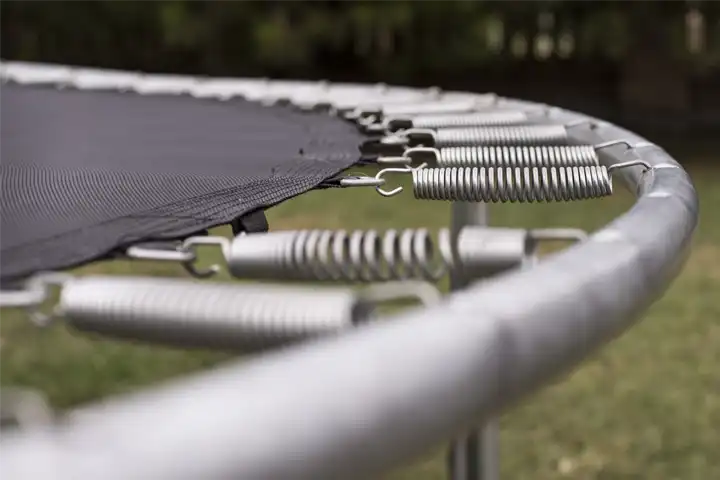
Longer lifespan
Most rebounder springs are constructed from galvanized rust-resistant springs. This gives a longer lifespan of your mini trampoline and the only maintenance you need to do is to lubricate the springs to prevent the noise.
Of course, over time, the springs might show signs of wear and tear. It's relatively easy and cheap to replace them. The only thing you need to watch out for is to find the right size of springs that are specifically designed for rebounders.
But if you choose a cheaper option for your spring mini trampoline, this might mean a compromise with the quality. You might end up replacing parts might be a lot more often than you typically need to.
More affordable
When it comes to bungee vs. springs rebounders, price is definitely a factor. Spring rebounders are the well-known option that’s popular on the market and so it tends to be more widely available. My advice, though, is to invest in a proven brand for your spring rebounder to ensure a long lifespan of the equipment and most importantly your safety.
Cons of spring rebounders
Noisier
In the springs-vs-rubber-bands-for-rebounder battle, the winner in the “Silent” category is definitely the springless rebounder, unless you are considering the Cellerciser — that's in a category of its own.
In all other cases, the construction of the spring mini trampoline includes steel springs, connected to a steel frame, so you have “steel on steel” and this can’t be completely silent. You can solve that problem by lubricating the springs, but even in that case when they start wearing out, they’ll make noises.
Harder on joints
Many spring rebounders offer a sturdy, firm bounce which is shorter than the one on bungee mini trampolines because of the smaller elasticity. This means it reminds more of jumping on hard ground. This is not recommended for people with fragile joints or severe joint problems.
This type of bounce might be great for beginners and people who need more stability and coordination of their moves while jumping.
What is a spring rebounder good for?
Budget-conscious buyers
Spring trampolines are more widely known on the market and there are plenty of models you can buy. If saving money is a priority in your requirements list for bungee vs. springs rebounders, maybe a spring rebounder is the right choice for you.
Still, I’d suggest you pay a lot of attention to the structure, the brand, the setup of the mini trampoline, as well as to your individual specifics. That way you’ll make the right choice while keeping the budget in check at the same time.
People who prefer a firmer bounce
There are some cases where a firmer bounce is a plus.
If you’re a beginner and you don’t feel comfortable doing deep and variable bouncing on the rebounder – then you’ll prefer smaller but more stable jumps.
Also, for people who suffer from balance or coordination problems, the spring rebounder is the better option because it’s elastic, but much less elastic than the bungee one and it reminds more of hard ground.
Speaking of hard ground, you might also choose this option if you’re into jogging but find it harsh on your joints or back. The spring rebounder is constructed to absorb part of the pressure when landing on the surface.
Top 3 spring mini trampoline rebounders
Here is our take on the best bungee rebounders, considering different requirements and budgets.
Product | My Rating | Verdict | Price |
|---|---|---|---|
The unique patented spring technology offers a superior and adaptable rebounding experience that enhances whole-body strength. | |||
It’s a great option for those looking for a compact, quiet, and stable mini trampoline. Very good value for money. | |||
It’s a good choice for indoor rebounding if you’re looking for an affordable, compact exercise trampoline that has a solid construction and good bounce quality. |
The Bungee Rebounder
How does a bungee mechanism work?
What is a bungee rebounder? As the name suggests, this is a mini trampoline where the mat is attached to the frame with bungee cords. These cords ensure wider stretching and a gentler and deeper bounce. It’s safer for your joints and your back because part of the pressure is absorbed. This is thanks to the elasticity of the cords during the bounce.
Types of bungees used in rebounders
The bungee cords in no-spring trampolines can be classified in terms of strength. For example, bellicon rebounders are separated into 5 categories (soft, medium, strong, x-strong, ultra). The one you choose depends on your health condition, your weight, and your workout goals.
Your Weight | Health | Optimal Strength (Recommended) | Heavy | Jogging / |
|---|---|---|---|---|
< 80 lbs | soft | soft | medium | strong |
80-110 Ibs | medium | medium | strong | x-strong |
111 - 150 lbs | medium | medium | x-strong | x-strong |
151 - 180 lbs | medium | medium | x-strong | x-strong |
181 - 200 Ibs | strong | x-strong | x-strong | ultra |
201 - 320 lbs | x-strong | x-strong | ultra | ultra |
321 - 440 Ibs | ultra | ultra | ultra | ultra |
Durability and longevity
A rebounder with bungee cords doesn’t require regular maintenance, but the cords do wear out over time.
Be careful when replacing the bungees. They could snap back at you and injure you. It’s best to use a tool like the bungee puller tool used here to change the bungees of the BCAN mini trampoline:
Pros of bungee rebounders
Quieter
In the bungee vs. springs rebounders debate, bungee cord mini trampolines definitely lead in this category. They are designed to be quiet. This is a plus, not only because you can enjoy your workout more, but also because you get a silent bounce without any maintenance needed, which is usually not the case with the spring rebounder.
Softer on joints
Another benefit of the bungee mini-trampoline over the spring one is the deep gentle bounce it offers. This is key when it comes to protecting your joints. Since it’s more elastic, the mat absorbs more of the pressure when you land on it. The deep bounce, however, makes your muscles work more intensely. This can be another plus of this type of rebounder because you burn more calories.
Higher weight capacity
All rebounders and trampolines have weight capacity that you have to consider before buying one. That capacity depends mainly on the diameter of the frame – the wider the frame, the more capacity the rebounder has. Because bungee rebounders are usually larger than spring ones more models of that type fall in the heavy-weight mini trampoline category.
Cons of bungee rebounders
More expensive
If you compare bungee vs. springs rebounders on pricing, you will notice that the latter tend to be more affordable. In many cases, the price corresponds to the quality, but there are also many options on the market with questionable quality of the materials and the rebounder itself. So, do your research to pick a rebounder that fits your needs best.
May need to replace bungees often
One drawback of bungee rebounders is that the bungee cords can lose elasticity over time or break, especially with frequent use. This means they may need to be replaced regularly to maintain proper bounce performance and safety. Lower-end models will need bungee replacements more often.
What is a bungee rebounder best for?
Low-impact exercise
Due to the elasticity of the cords of bungee rebounders, the bounce itself is very gentle and flexible. This keeps your back and joints safe during a workout. At the same time, it boosts the calorie burn and the lymphatic drainage more than the spring ones since you need to work your muscles more to be able to jump high enough.
So if your main goal is to lose weight or to detox your body, every rebounder will help, but the bungee type is a bit more effective in that aspect. And if your goal is to get fit, again, every rebounder will help.
Louis Coraggio, creator of the famous TrampoLean workout in New York City, says:
“Jumping up and down requires your body to increase oxygen uptake”
Quieter workout experience
A quiet fitness trampoline might be a priority for you if you want to avoid disturbing the neighbors, want to sneak a workout while your kid is sleeping, or especially if you work at a fitness center and you have 10 people bouncing together in one room.
If quietness is important to you, a rebounder with no springs may be the way to go. There are many spring rebounders that are relatively quiet, like the BCAN 40/48 inch rebounder – the current leader in our review of the best rebounder trampolines.
Still, keep in mind you can’t keep the noise down to zero if you have two steel parts (the springs and the frame) rubbing each other. Also, if one of the springs starts wearing out, the noise will be inevitable.
Top 3 bungee mini trampoline rebounders
Here is our take on the best bungee rebounders, considering different requirements and budgets.
Product | My Rating | Verdict | Price |
|---|---|---|---|
The bellicon offers the smoothest, most elastic bounce available, making it the top choice for a bungee rebounder. You can't go more premium than this. | |||
JumpSport rebounders provide a stable, controlled bounce that’s gentle on the joints. Their big selling point is the ability to regulate bungee tension. | |||
This is a solid entry-level option for beginners. The firm bungee cords support light, rhythmic bouncing that boosts circulation, though its a less deep and refined bounce than higher-end models. |
Spring vs. bungee rebounder for lymphatic drainage
Spring Rebounders
Many spring rebounders offer a sharper bounce. However, for lymphatic drainage, this can sometimes be a bit jarring, especially on the joints. The impact may create extra pressure on your knees and back. And this can limit your ability to sustain longer rebounding sessions. That said, spring rebounders are generally more affordable and can still promote lymph flow effectively. The potential problem is they might not offer the smoothest or most comfortable experience for people who need a gentler, low-impact workout.
Bungee Rebounders
Bungee rebounders are the go-to choice for people who need a softer, more cushioned bounce. The elastic cords absorb much of the impact, making it ideal for joint protection during longer sessions. This gentle motion makes the bellicon an amazing rebounder for lymphatic drainage because it allows your body to keep moving fluidly without putting strain on your joints. You can have longer bouncing sessions and the smooth, low-impact bounce helps stimulate the lymphatic system. Bungee rebounders can be pricier and even downright expensive, but they’re great if comfort and joint health are your priority.
My top-choices for bungee rebounders for lymphatic drainage are the bellicon and for those who want the very best) and the Leaps and Rebounds (for those who don't want to invest as much).
The Cellerciser®—A Third Option
The Cellerciser® is different. It’s a spring rebounder, but it has special triple-tiered springs. These springs adjust with your movement, so the bounce is much smoother and softer than a typical spring model.
This mini trampoline is great for lymphatic drainage because it gives you the benefits of a spring rebounder while being gentle on your joints. Think of it as the best of both worlds!
So, if you’re looking for something in between the firm bounce of a spring and the soft feel of a bungee, the Cellerciser® is your third option. It's a unique mix of smooth, strong, and easy on the joints. For more information, read my in-depth Cellerciser® review here and my Cellerciser® vs. bellicon breakdown.
Maintenance and care
Tips for spring rebounders
One important thing to do in terms of maintenance of a spring trampoline is to ensure the springs are lubricated so they remain quiet. Also, it’s very important to watch out if any of the springs start to wear out. If that happens, simply buy the right size of spring and there shouldn’t be much trouble replacing it by yourself. Just remember to get a spring puller tool.
Tips for bungee rebounders
Weight capacity is among the key factors when choosing a bungee rebounder is the weight capacity. This is crucial for your safety.
In terms of maintenance, the bungee cords tend to be quite durable, but if you see that any of them have lost their elasticity, you can change them in a few simple steps. A big plus is that you don’t need to do that initially because they mostly come pre-assembled, which is not the case with spring ones.
Bungee vs. Springs Rebounders: How to Choose?
The upfront investment of money in a premium quality product is also a thing to consider in bungee vs. springs rebounders. Cheap rebounder mini trampolines are constructed with cheap materials and, no surprise here, these get worn out quicker. That way, you’ll save time and money in the long run. To choose a rebounder that is worth your money keep an eye on these factors:
- Height Off the Ground: A rebounder should stand over 9 inches off the ground to ensure you're getting the proper bounce necessary for an effective workout.
- Unit Weight: Look for rebounders weighing over 10 kilograms as anything lighter may not provide the stability needed for safe, effective rebounding exercises.
- Supplier's Location: Opting for a supplier with local customer service and warehousing promises better support and potentially quicker resolution of any issues.
- Company's Expertise: There's a difference between companies that offer a wide range of products and those specialized in rebounding. The latter are likely to provide products better suited to your needs and more knowledgeable support.
- Company and Product Track Record: Investigate customer reviews not just for the product but also for the company's customer service. It's telling if a company stands by their product and supports customers effectively, especially when things go awry.
- Certification: Validating that the product has passed safety and quality tests in your region (be it UK/EU/USA) is essential for ensuring the product meets standard regulations and is safe to use.
Bungee vs. springs rebounders: Which rebounder should you get?
If you’re after the best rebounder and you can possibly get, buy a bellicon. If you want something just as good but a bit more affordable and you don't care about silent jumping that much, get a Cellerciser® Tri-Fold Pro. For a more affordable spring mini trampoline, my value-for-money recommendation is the BCAN 40/48-inch spring rebounder. If you need an affordable bungee rebounder, try Leaps and Rebounds.
Of course, if you are in search of a more budget-friendly option, don’t get discouraged! The BCAN 38-inch mini trampoline is a great buy under $100.
Read my full reviews of the best rebounders here.
FAQ
Can I switch from a spring to a bungee system?
In terms of jumping, yes, you can switch from jumping on a spring rebounder to jumping on bungee rebounder and vice versa. You may notice the differences initially, but you will get used to them.
Switching from a spring to a bungee system (or vice versa) is generally not straightforward because the frame and other parts are designed specifically for the type of tension system they use. However, some specialized models might allow for a swap, although this is rare. It will be easier to just buy a new one.
Are there hybrid models that use both springs and bungees?
I haven’t seen hybrid models that use both springs and bungees. Its bungee vs. springs rebounders and nothing in-between. Most rebounders are designed to use one system or the other. Hybrid models, if available, would aim to provide a blend of the features of both types but could also complicate maintenance and replacement of parts.
How often should I replace the springs or bungees?
The lifespan of springs or bungees varies depending on usage and the quality of the material. Springs often last between 1 to 5 years, while high-quality bungees can last up to several years. Always refer to the manufacturer's guidelines for specific information and look out for signs of wear and tear.
Can I perform the same exercises on both types of rebounders?
Yes, you can generally perform the same exercises on both types of rebounders. However, the experience may differ due to the tension and bounce provided by each system. For example, bungee rebounders often offer a softer, quieter bounce, which some people find more suitable for low-impact exercises. Spring rebounders, on the other hand, might provide a firmer bounce, which could be suitable for more rigorous workouts.
Are springless trampolines less bouncy?
Springless (or bungee) trampolines are not generally not less bouncy, but the quality of the bounce is different. Bungee trampolines provide a softer, smoother bounce because the elastic bungee cords absorb more of the impact and offer a slower rebound than metal springs. This can make the bounce feel less intense and may reduce the height you can achieve compared to a spring trampoline, which typically has a firmer bounce and quicker rebound.
Is a Spring or Bungee Rebounder Better for a HIIT Workout?
For a HIIT workout, a spring rebounder might be the better choice due to its quicker return and ability to support faster-paced exercises. Spring rebounders offer a firmer tension, making them ideal for more intense workouts, where the goal is to increase heart rate and energy expenditure quickly. This type of rebounder suits those looking for a challenging fitness session, as it facilitates bouncing at a faster tempo, which is common in mainstream fitness rebound classes or workouts.
Conclusion
In conclusion, solving the bungee vs. springs rebounders debate is a matter of personal preference and fitness objectives. Spring models are often budget-friendly, widely available, and offer a vigorous workout but can be noisy. The cheaper models can be a bit tough on joints. Bungee types, usually pricier and quieter, may provide a gentler bounce that’s kinder to your body. However, some models may have the opposite effect and make it difficult to jump because they sag in the middle. It's hard to tell whether spring or bungee rebounders are better in general because it depends on the quality of the product and the price tier you're in.
No matter which you choose, it's all about getting a quality rebounder that matches your rhythm. Whether you're bouncing to the beat of high-intensity workouts or flowing through a zen-like bounce session, the right rebounder will keep you moving and grooving to your fitness goals!
References & Further Reading
- ☑️ Checklist: What to Look for When Buying a Rebounder
- What is a spring device?
- What Is a Stainless Steel Spring Tube?
- What Are Tapered Springs?
- How do bungee cords work?
- Best Rebounder Exercise Trampolines for Adults for Any Budget
- Burn 250+ Calories with These Fun Mini Trampoline Exercises for Weight Loss


